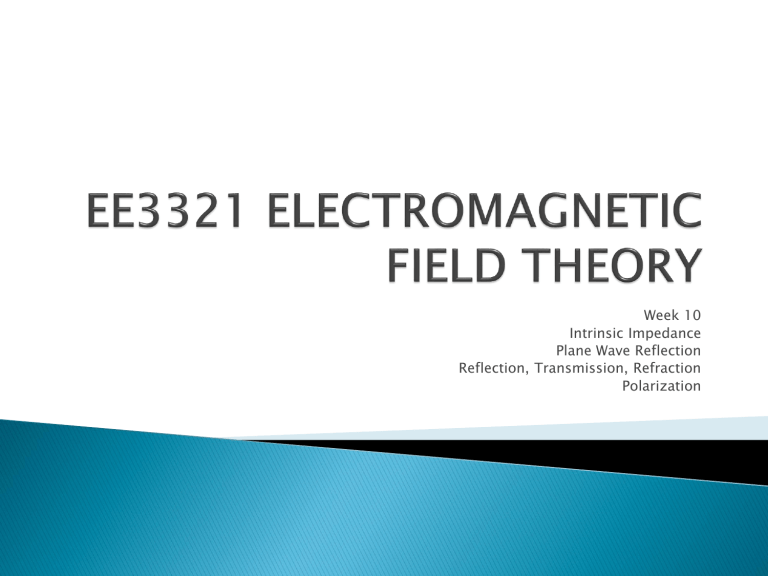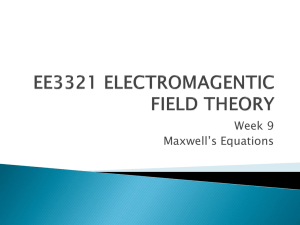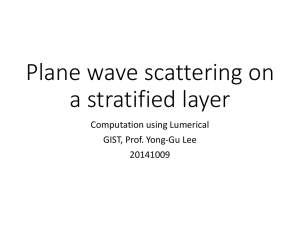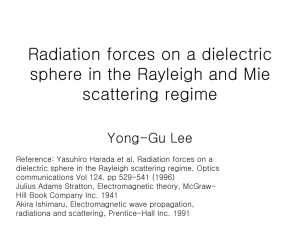EE3321 ELECTROMAGNETIC FIELD THEORY

Week 10
Intrinsic Impedance
Plane Wave Reflection
Reflection, Transmission, Refraction
Polarization
Any medium through which plane waves propagate have a property called intrinsic impedance or electromagnetic impedance, denoted by η.
The intrinsic impedance is analogous to the characteristic impedance of a cable in transmission line theory.
For a given frequency, the intrinsic impedance of a homogeneous material is given by the ratio of the E field phasor to the H field phasor.
Consider a plane wave with fields
E = E i e jωt e –jkz a x
B = B i e jωt e –jkz a y
Recall that these fields are related by
– jk E i e jωt e –jkz a y
= – jω B i e jωt e –jkz a y
Since H = B / μ it follows that
– jk E i e jωt e –jkz a y
= – jωμ H i e jωt e –jkz a y kE i
= ωμ H i
η = E i
/H i
= ωμ/k
η = (μ/є) 1/2
In free space μ r
= 1 and ε r
= 1.
Therefore the intrinsic impedance of free space η o is given by
η o
= 120 π which is approximately 377 Ω.
For a region with slight electrical conductivity
(σ > 0, e.g. seawater), the equation becomes
This means that the E and H fields will be out of phase.
Exercise:
What is the intrinsic impedance of a perfect conductor?
When a plane wave passes from one dielectric medium (A) to another medium (B) with different intrinsic impedance, a fraction of its energy will be reflected and the remainder will be transmitted through the interface.
In this case, a reflection coefficient is used to describe the amplitude of the reflected part of the wave relative to the amplitude of the incident wave.
The arrows indicate the direction of propagation
In particular, the reflection coefficient is the complex ratio of the electric field phasor of the reflected wave ( wave (
E
+ ).
E
− ) to that of the incident
This is typically represented with a Γ (capital gamma) and can be written as:
Let the intrinsic impedances of the first and second media be η
1 and η
2
, respectively.
At normal incidence the reflection coefficient of medium 2 relative to 1 is given by
Exercise: A plane wave hits a mirror at normal incidence. Determine the reflection coefficient.
Incident wave
E i
= E i e jωt e –jkz a x
H i
= H i e jωt e –jkz a y and η
1
= E i
/ H i
Reflected wave
E r
= E r e jωt e jkz a x
H r
= H r e jωt e jkz a y and η
1
= - E r
/H r
At the interface, the components of the electric field and magnetic field parallel to the surface must be continuous.
Consequently the following boundary condition must be satisfied:
E i
+ E r
= E t
H i
+ H r
= H t
This yields
E i
+ ΓE i
= E t
E i
/η
1
– ΓE i
/η
1
= E t
/η
2
(1 – Γ)/η
1
= (1 + Γ)/ η
2
Γ = (η
2
– η
1
) / (η
2
+ η
1
)
When the electric field E i is incident upon a perfectly conducting plate located a z = 0, the reflected field is
E r
= ΓE i e +jωt e +jkz x.
The total field in region 1
E
1
= E i
+ E r
= E i e +jωt (e –jkz + Γe +jkz ) x
Since Γ = –1, the expression simplifies to
E
1
= E i
+ E r
= E i e +jωt (e –jkz – e +jkz ) x
E
1
= – 2j E i e +jωt sin (kz) x
Taking of the real part of E
1 yields
E
1
= 2E i sin (ωt) sin (kz) x
Exercise:
Derive an expression for the total electric field if the reflection coefficient is Γ =
1.
Standing Wave in a Microwave Oven
Consider the stationary electric field in a microwave oven:
E = E o e jωt sin (kz) a x
V/ m
The oven operates at a typical frequency of 2.45
GHz. The width of the oven W is 2.5 λ.
The electric field is zero on the side walls of the oven (i.e. at z = 0 and z = W).
What is the width of the oven?
Is this a traveling wave or a standing wave?
What are the boundary conditions in the oven?
How many hot spots are there?
Where is |E| the strongest? In other words, where do you put the turkey?
The transmission coefficient τ is used when a plane wave encounters a change in the intrinsic impedance.
The transmission coefficient describes the amplitude of the transmitted wave relative to the incident wave.
The transmission coefficient is a measure of how much of an electromagnetic wave passes through a surface.
The transmission coefficient τ is defined as the ratio of the transmitted electric field to the ratio of the incident electric field.
When the electric field E
0, the reflected field is i is incident upon a surface located a z =
E t
= τ E o e +jωt e –jkz x.
At the interface, the component of the electric field parallel to the surface must be continuous.
Consequently the following boundary condition must be satisfied:
E i
(0) + E r
(0) = E t
(0)
E i
+ ΓE i
= τ E i or 1 + Γ = τ
When an electromagnetic field moves from a medium of a given refractive index n refractive index n
2
, both reflection and refraction of the plane wave may occur.
into a second medium with
An incident plane wave PO strikes at point O the interface between two media of refractive indexes n
1 and n
2
.
Part of the wave is reflected as wave
OQ and part refracted as ray OS. The angles that the incident, reflected and refracted waves make to the normal of the interface are given as θ respectively.
i
, θ r and θ t
,
The law of reflection states that the direction of the incident plane wave and the direction of the reflected plane wave make the same angle with respect to the surface normal.
That is, the angle of incidence equals the angle of reflection:
θ i
= θ r
Exercise: An electromagnetic plane wave is reflected by a perfect conductor. The angle of incidence is
45 o . What percentage of the wave will be reflected at 30 o ?
Snell's law (also known as
Descartes' law or the law of refraction) describes the relationship between the angles of incidence and refraction, when referring an electromagnetic wave, passing through a boundary between two different isotropic media, such as water and glass.
The law says that the ratio of the sines of the angles of incidence and of refraction is a constant that depends on the media.
The refraction of an electromagnetic wave occurs at the interface between two media of different refractive indices, with n
2
> n
1
.
Since the velocity is lower in the second medium (v
θ
2
< v
1
), the angle of refraction is less than the angle of incidence θ
1
.
That is, the ray in the higher-index medium is closer to the normal.
When light moves from a dense to a less dense medium, such as from water to air, Snell's law cannot be used to calculate the refracted angle when the resolved sine value is higher than 1.
At this point, light is reflected in the incident medium, known as internal reflection.
Before the ray totally internally reflects, the light refracts at the critical angle; it travels directly along the surface between the two refractive media, without a change in phases like in other forms of optical phenomena.
In order to calculate the critical angle, let θ
2
90 o and solve for θ crit
:
=
When θ
1
> θ crit
, no refracted ray appears, and the incident ray undergoes total internal reflection from the interface medium.
The index of refraction of water at optical wavelengths is approximately 1.33.
Suppose that a swimmer is underwater looking up at the water-air interface.
Determine the minimum angle at which she starts seeing the bottom of the pool reflected on the interface.
Polarization is a property of waves that describes the orientation of their oscillations.
A polarizing filter, such as a pair of polarizing sunglasses, can be used to observe this effect by rotating the filter while looking through it at the reflection off of a distant horizontal surface.
At certain rotation angles, the reflected light will be reduced or eliminated.
For a simple harmonic wave, where the amplitude of the electric vector varies in a sinusoidal manner in time, the two components have exactly the same frequency:
E x
= E x exp [ jθ x
] exp [ j(ωt – k z z) ] a x
E y
= E y exp [ jθ y
] exp [ j(ωt – k z z) ] a y
The two components may not have the same amplitude:
E x
≠ E y
The two components may not have the same phase, that is they may not reach their maxima and minima at the same time:
θ x
≠ θ y
In the figure below, the E field is propagating in the + z direction.
The field has two components
E x and E y.
The components are both in phase and orthogonal
(perpendicular) to each other.
In the case of circular polarization, the two orthogonal components E x and E y have exactly the same amplitude and are exactly ninety degrees out of phase.
In this case one component is zero when the other component is at maximum or minimum amplitude.
The direction the field rotates in, depends on which of the two phase relationships exists.
Depending on which way the electric vector rotates these cases are called
◦
◦ right-hand circular polarization and left-hand circular polarization .
In electrical engineering, the rotation is defined as seen from the source , such as from a transmitting antenna.
More generally, the two components are not in phase and do not have the same amplitude.
In this case the polarization is called elliptical polarization because the electric vector traces out an ellipse in the plane (the
polarization ellipse
).
Read book sections 7-1, 7-2, 7-3, 8-1, 8-2
Solve end-of-chapter problems 7.1, 7.5,
7.10, 8.1, 8.17






![Kaikoura Human Modification[1]](http://s2.studylib.net/store/data/005232493_1-613091dcc30a5e58ce2aac6bd3fb75dd-300x300.png)

